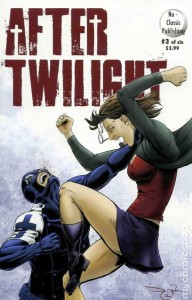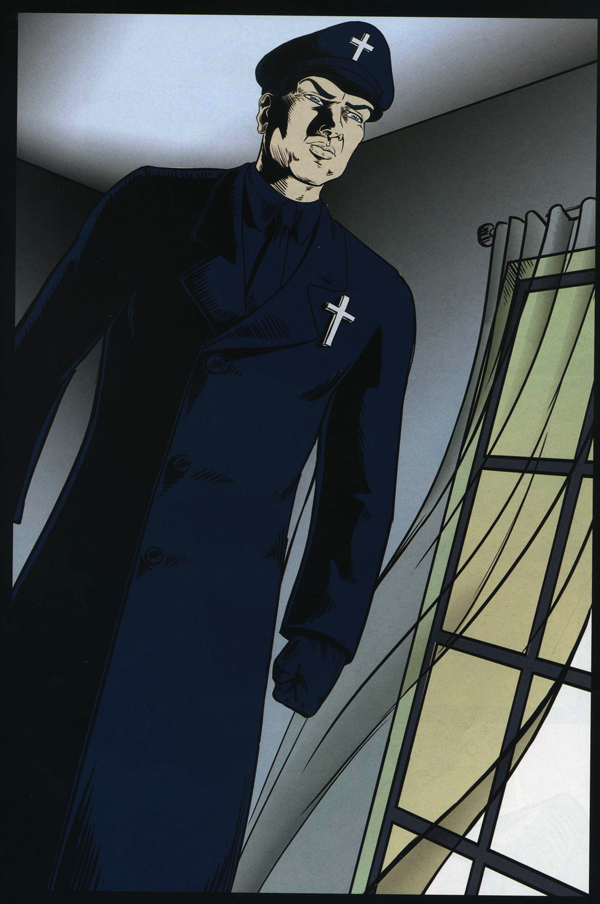AFTER TWILIGHT: Fighting Theocracy, Comic Book Style

Growing up in Texas I came across more than my fair share of religious fundamentalists, many of whom were my best friends. Most of these people were just overzealous Christians eager to spread what they viewed as the word of God, but occasionally I’d run into someone who felt that the United States was a Christian nation and that those people who weren’t Christian couldn’t truly call themselves Americans.
According to these religious extremists, America had deviated from the religious principles on which it had been founded, and the only way for our country to become truly great again would be by embracing religion, specifically Christianity, and some of the more extreme values that these fundamentalists claim it professes. This meant, among other things, putting Bibles back in schools, mixing religion with government, and discouraging non-Christians from entering or staying in our country.
It’s with this background in mind that I began to read the AFTER TWILIGHT comic book series, written by Gary Watson, Richard Alvarez, Sandra Yates, and drawn by Douglas Brown. The comic, a short six-issue story arc, is based in the near future where Texas has morphed into a theocracy and is struggling to eradicate heretics at home while seceding from the Union and fighting the federal government for independence.
 Without giving too much away, this scenario is put in to place by of events that occurred in the backstory in 2012 and 2013. Around this time, the Texas government had grown increasingly conservative and was changing school textbooks to be more religious and conservative, while also cracking down on individuals deemed to be social deviants. As a result of this crackdown, some liberal and secular activists resorted to terrorism, destroying churches and other buildings as a means of retaliation, while others engaged in peaceful protest. This cycle of violence resulted in an even more religiously conservative government getting elected, which in turn transformed the state into a theocracy and began to seek independence from the relatively irreligious United States of America.
Without giving too much away, this scenario is put in to place by of events that occurred in the backstory in 2012 and 2013. Around this time, the Texas government had grown increasingly conservative and was changing school textbooks to be more religious and conservative, while also cracking down on individuals deemed to be social deviants. As a result of this crackdown, some liberal and secular activists resorted to terrorism, destroying churches and other buildings as a means of retaliation, while others engaged in peaceful protest. This cycle of violence resulted in an even more religiously conservative government getting elected, which in turn transformed the state into a theocracy and began to seek independence from the relatively irreligious United States of America.
The protagonist of the story, which is set in the 2020s, is Jen Frazier, the daughter of one of the original activists that opposed the growing religiosity of the Texas government back in 2012. Jen, who is reluctant to fight against the new theocratic government of Texas, sees her passivism challenged when her family members are imprisoned, and finds herself following in her mother’s footsteps by joining those opposed to this new government.
The series itself is notable for its original setting and for its interesting social commentary on the value and pitfalls of violent protest and resistance. At the same time, the occasionally heavy-handed nature of its diatribes against fundamentalist religion detract from those strengths. The antagonists of the series, religious extremists who have killed and manipulated their way in to power, are completely unsympathetic and static characters meant to be the personification of evil and zealotry, and their unchanging and extreme nature prevents the reader from understanding why they do what they do or from forming any sort of attachment. Furthermore, the comic’s critique of the common man who supports this regime is extremely patronizing, casting all religious folk as hyper-authoritarian ignoramuses. While painting an entire populace with such a broad stroke is advantageous if one wishes to create a dystopian society, its unrealistic nature ends up just being a distraction from the better aspects of the comic.
Another issue with the comic is the clichéd inclusion of disproportionately big-breasted and scantly clad women, which has plagued male-created comics for decades and typically serves only to degrade otherwise strong female characters and distract from the story. That being said, the vaguely pornographic presentation of female characters does have some relevance to the larger story in AFTER TWILIGHT due to the restrictions on promiscuous clothing that are enforced by the theocratic government in the new Texas republic.

Overall, AFTER TWILIGHT shows various signs of promise, but its simplistic approach to the relationship between religion and government and the motivations of religious fundamentalists left me a bit frustrated. The comic could really come in to its own if the series was continued and the creators gave a bit more depth to the leaders and supporters of the theocracy, or at the very least cast the “freedom fighters” as something a bit darker than the uber-liberal good guys.
AFTER TWILIGHT originated in 2004 as a thirty-minute short film (available for streaming on Vimeo On Demand), followed by the comic (published by Nu-Classic Publishing and sold in digital and print form at aftertwilightcomics.com). Now the creators are exploring options to turn it into a feature-length film, which could surely allow for more character development and nuance. Watson, who directed and produced the short film, says:
The intention while writing AFTER TWILIGHT was to portray a disturbing, extremist society that would not necessarily be outside the realm of possibility. That was underscored by the fact that we could never completely stay ahead of the reality curve. Actions that we would imagine for our script would show up as actual events or issues in the newspapers weeks later—and it continues to happen to this day.
Fundamentalism is certainly a big issue in modern America, be it of the religious or political sort, which is why stories like AFTER TWILIGHT that deal with this issue are so interesting and important.
